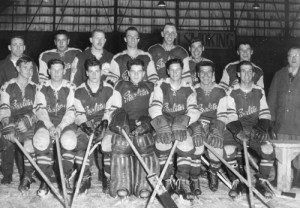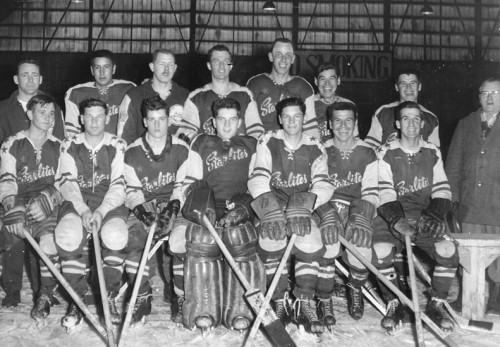 EDITOR’S NOTE: After the success of the Sheguiandah Bears Senior Hockey Team reunion this fall and the many stories regarding the league that came to light as a result, The Expositor decided to delve into the history of the once-popular Manitoulin Senior Hockey League (MSHL), its teams and its players. This is the second part of a series.
EDITOR’S NOTE: After the success of the Sheguiandah Bears Senior Hockey Team reunion this fall and the many stories regarding the league that came to light as a result, The Expositor decided to delve into the history of the once-popular Manitoulin Senior Hockey League (MSHL), its teams and its players. This is the second part of a series.
by Alicia McCutcheon
LITTLE CURRENT—Lacing their skates and donning the Little Current jersey to represent their hometown in the Manitoulin Senior Hockey League (MSHL) meant everything to the boys on the ice and to their adoring fans some 50 years ago.
Whether playing for the Starlites, the Essos or the LCs (the team went through a significant amount of name changes) the heart of it always remained the same—these players were playing on behalf of Little Current and that meant doing the crowd proud.
Jim Still played for the team from 1947, before and after he came home from the Korean War. It was after the war, he said, that the league began “to mushroom.”
“I was 15-years-old in 1947 and we had a lot of fun,” he said.
“There were a lot of good players—Ed Morphet, Floyd Morphet,” he recalled, and named Gore Bay, Little Current, Sheguiandah, Wikwemikong and Killarney as the teams in the league.
“Players used to skate from Killarney, play a game, then skate back,” Mr. Still said.
Mr. Still was the goaltender for the team but, when off to serve his country, was replaced by Bob Hoskins.
The 79-year-old remembered the rivalry between Little Current and Gore Bay well.
“I remember one game, we went to Gore Bay and the crowd, including police officers, wouldn’t let us in the arena,” he said. “We eventually got in and we won, too.”
Bill Cunningham, another Little Current player, recalled his ferocious rivalry with the late Godfrey Porter of Gore Bay—one that even put Mr. Cunningham in hospital.
“He was a mean sucker and he would get under your skin, but we eventually ended up as friends once our hockey career was over,” he chuckled. “Godfrey Porter and I used to tangle pretty well every game. It got to be so you had to take a round out of him or take the dirt he dished out. The crowd loved it though.”
When asked about a photo of the right-winger in hospital with two black eyes, he replied, “I can still feel it, anyway,” pointing to his slightly off-centre nose with a smile.
“I had a broken nose, a broken hand and a broken heart, but Jean (his wife) fixed that,” Mr. Cunningham grinned.
The right-winger attributes at least some of the contention between teams to jealousy. “We had a better rink than they did for awhile, but the rivalry goes back to before my time on the ice,” he explained. “We had the first enclosed rink, followed by Gore Bay.”
Mr. Still explained how the rink was readied, located at the site of Little Current RONA Building Centre, for the relatively short season of play. “They hauled in snow, then tramped it all down and watered it—the players helped with that,” he added. “We played in December too. We had pretty good winters then.” Players changed in old railway bunkers beside the arena.
Peewee Oliver had the interesting distinction of having played for both Little Current and Gore Bay teams. Mr. Oliver played junior hockey for the Soo Greyhounds in the 1940s and, at age 19, moved to Gore Bay for work. He eventually moved, following his work, to Little Current where he picked up the stick for the “other guys.”
“I eventually moved back to Gore Bay, and they didn’t think much of that,” he laughed. “It was quite a rivalry between Little Current and Gore Bay, but it was good hockey too. “We had players here that would have had tryouts in the NHL if there were as many teams as there are today.”
Playoffs for the league came in late February and “we used to pack that arena so full, little kids used to sit across the beams in the arena,” Mr. Still said.
“It was real good,” Harold Morphet said of the hockey during the MSHL years. “When you went to the arena late, you couldn’t get in.”
When asked about rivalries, Mr. Morphet responded, “anybody and Gore Bay—we hated them and they hated us. Nobody liked Gore Bay—there was no friendship there, I tell you.”
Eventually, he continued, the boys got to know one another off the ice, through other venues like curling and golfing and maybe even got to be friends. “It was stupid the way we all were,” he lamented.
Mr. Oliver recalls playoff games in “the shoebox,” as the old Vankoughnet Street arena was known, with the venue eventually changed to Providence Bay, then Mindemoya, to accommodate the crowds. “In Gore Bay we couldn’t even get to the dressing rooms there were so many people, so we just stayed in the players’ box between periods,” he added.
“There was no television in those days and it was good hockey,” Mr. Oliver added.
The memories are fond and many, too. The ace player laughed, remembering having to push the bus up the 10 Mile Point Hill on the way to a Wikwemikong game. He shared the experience of breaking down on the Bidwell Road, tearing up and burning a farmer’s split rail fence to make a fire and keep warm. “That morning the farmer took us all in and made us breakfast!” he laughed, noting the team eventually replaced the damaged fence.
Mr. Cunningham remembered traveling to Killarney on a couple of occasions in the back of a truck on the ice road. “It must have been cold?” this reporter asked. “And scary,” he nodded.
Mr. Cunningham said he stopped playing in the 1970s when the league started to lose popularity and sportsmen hockey became the game of choice. Mr. Morphet played right until the league ended in the 1980s and is still reknowned for his hockey prowess, his name often leading the charts in old Expositor standings and he’s not shy to tell you about it either. The duties of being a husband and father took Mr. Still from his favourite game, while all the players point to the introduction of television in the family home to the start of the demise of Manitoulin’s most loved game.




